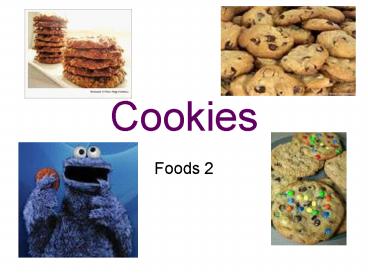Cookies - PowerPoint PPT Presentation
1 / 9
Title:
Cookies
Description:
Cookies have a heavier texture than cake. Texture can be soft or crisp. ... Sliced (refrigerator, freezer) baked on a cookie sheet, made from soft dough, ... – PowerPoint PPT presentation
Number of Views:2697
Avg rating:5.0/5.0
Title: Cookies
1
Cookies
- Foods 2
2
Cookie Basics
- The main difference between cakes and cookies is
the amount of liquid added. - Cookies have a heavier texture than cake.
- Texture can be soft or crisp.
- Cookies can come in assorted shapes and sizes.
- Cookies can be decorated in variety of ways.
3
Types of Cookies
- Bar- baked in a square or rectangle pan.
- Made from batter or soft dough, texture can be
cake like and chewy. - Example brownies.
- Drop-baked on cookie sheets, made from soft dough
and dropped onto sheets, texture is chewy. - Example Choc chip cookie
4
Types of cookies
- Cut out (rolled)-baked on a cookie sheet, made
from a stiff dough, texture is crispy. - Example sugar cookies
- Molded- baked on a cookie sheet, made from dough
balls, rolled in something or flattened, can be
crunchy or chewy. - Example peanut butter cookies
5
Cookie Types
- Pressed- Baked on a cookie sheet, pushed through
a cookie press, texture is light and crispy. - Example Spritz cookies
- Sliced (refrigerator, freezer) baked on a cookie
sheet, made from soft dough, rolled into a log
shape and sliced. Texture is crunchy. - Example Pinwheel cookie
6
Baking Cookies
- Let cookies cool in between baking.
- Bar cookies are ready when they start to pull
away from the sides. - Bottom of cookies should be light brown.
7
7 steps to the baking process
- 1. Formation and expansion of gasses.
- Leavening Agents (baking soda, baking powder,
yeast, air)- are heated and start to release
gasses (CO2) - Starts within 3 minutes in the oven.
- 2. Trapping of gasses in air cells
- Gasses being trapped into the gluten strands of
flour.
8
7 steps in the baking process
- 3. Gelatinization of starches (in flour) (_at_140
degrees)- internal temperature. - 4. Coagulation of proteins (gluten, eggs, milk)
(_at_165 degrees)- internal temp. - 5. Evaporation of some of the moisture
- Starting to dry out, (170-175 degrees)
9
7 steps to the baking process
- 6 Melting of fats- tenderizes the product,
should happen after step 5 so that fats are not
lost - 7 Crust formation and browning
- Sugar will carmelize, longer time- deeper the
color (min. temp. 185 degrees- up to 240 degrees)

